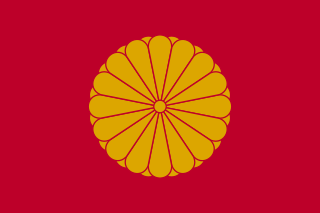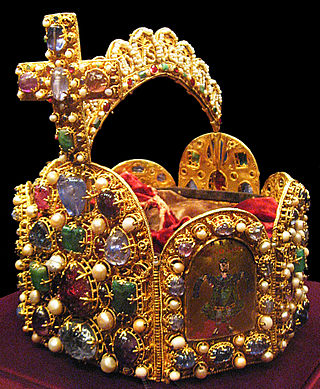
The emperor of Japan is the hereditary monarch and head of state of Japan. The emperor is defined by the Constitution of Japan as the symbol of the Japanese state and the unity of the Japanese people, his position deriving from "the will of the people with whom resides sovereign power". The Imperial Household Law governs the line of imperial succession. Pursuant to his constitutional role as a national symbol, and in accordance with rulings by the Supreme Court of Japan, the emperor is personally immune from prosecution. By virtue of his position as the head of the Imperial House, the emperor is also recognized as the head of the Shinto religion, which holds him to be the direct descendant of the sun goddess Amaterasu. According to tradition, the office of emperor was created in the 7th century BC, but the first historically verifiable emperors appear around the 5th or 6th centuries AD.

The Holy Roman Empire, also known as the Holy Roman Empire of the German Nation after 1512, was a polity in Central and Western Europe, usually headed by the Holy Roman Emperor. It developed in the Early Middle Ages and lasted for almost a thousand years until its dissolution in 1806 during the Napoleonic Wars.

Leopold I was Holy Roman Emperor, King of Hungary, Croatia, and Bohemia. The second son of Ferdinand III, Holy Roman Emperor, by his first wife, Maria Anna of Spain, Leopold became heir apparent in 1654 after the death of his elder brother Ferdinand IV. Elected in 1658, Leopold ruled the Holy Roman Empire until his death in 1705, becoming the second longest-ruling Habsburg emperor. He was both a composer and considerable patron of music.

Emperor or Empress of India was a title used by British monarchs from 1 May 1876 to 22 June 1948 to signify their sovereignty over the Indian Empire as its imperial head of state. The image of the emperor or empress appeared on Indian currency, in government buildings, railway stations, courts, on statues etc. Oaths of allegiance were made to the emperor or empress and the lawful successors by the governors-general, princes, governors, commissioners in India in events such as imperial durbars.

A pendant is a loose-hanging piece of jewellery, generally attached by a small loop to a necklace, which may be known as a "pendant necklace". A pendant earring is an earring with a piece hanging down. Its name stems from the Latin word pendere and Old French word pendr, both of which translate to "to hang down". In modern French, pendant is the gerund form of pendre and also means "during". The extent to which the design of a pendant can be incorporated into an overall necklace makes it not always accurate to treat them as separate items.

Roman currency for most of Roman history consisted of gold, silver, bronze, orichalcum and copper coinage. From its introduction during the Republic, in the third century BC, through Imperial times, Roman currency saw many changes in form, denomination, and composition. A feature was the inflationary debasement and replacement of coins over the centuries. Notable examples of this followed the reforms of Diocletian. This trend continued with Byzantine currency.

The Iron Crown is a reliquary votive crown, traditionally considered one of the oldest royal insignia of Christendom. It was made in the Middle Ages, consisting of a circlet of gold and jewels fitted around a central silver band, which tradition held to be made of iron beaten out of a nail of the True Cross. In the later Middle Ages, the crown came to be seen as a heritage from the Kingdom of the Lombards and was used as regalia for the coronation of some Holy Roman Emperors as kings of Italy. It is kept in the Duomo of Monza.

The Holy Crown of Hungary, also known as the Crown of Saint Stephen, named in honour of Saint Stephen I of Hungary, was the coronation crown used by the Kingdom of Hungary for most of its existence; kings were crowned with it since the twelfth century. The Crown symbolized the King's authority over the Lands of the Hungarian Crown, and it was a key mark of legitimacy. Through the history of Hungary, more than fifty kings were crowned with it, with the last being Charles I in 1916. The only kings not so crowned were Wladyslaw I, John Sigismund Zápolya, and Joseph II.

The Imperial Crown of the Holy Roman Empire, a hoop crown with a characteristic octagonal shape, was the coronation crown of the Holy Roman Emperor, probably from the late 10th century until the dissolution of the Holy Roman Empire in 1806. The crown was used in the coronation of the King of the Romans, the title assumed by the Emperor-elect immediately after his election. It is now kept in the Imperial Treasury at the Hofburg in Vienna, Austria.

Vetranio was briefly an imperial usurper and emperor in the Roman Empire in 350, during which time he controlled Illyricum between the rival emperors Magnus Magnentius and Constantius II, eventually capitulating to the latter.

Sol Invictus was the official sun god of the late Roman Empire and a later version of the god Sol. The emperor Aurelian revived his cult in 274 CE and promoted Sol Invictus as the chief god of the empire. From Aurelian onward, Sol Invictus often appeared on imperial coinage, usually shown wearing a sun crown and driving a horse-drawn chariot through the sky. His prominence lasted until the emperor Constantine I legalized Christianity and restricted paganism. The last known inscription referring to Sol Invictus dates to CE 387, although there were enough devotees in the fifth century that the Christian theologian Augustine found it necessary to preach against them.

The Imperial Crown of Austria is a crown formerly in use by the monarchs of the Habsburg monarchy. The crown was originally made in 1602 in Prague by Jan Vermeyen as the personal crown of Holy Roman Emperor Rudolf II, and therefore is also known as the Crown of Emperor Rudolf II. The crown was used as a private crown of the Holy Roman Emperors and Kings of Hungary and Bohemia from the House of Habsburg. In 1804 it became the official crown of the newly constituted Austrian Empire. After 1867 it remained the imperial crown of the Cisleithanian part of the Austro-Hungarian Empire until 1918.

A crux gemmata is a form of cross typical of Early Christian and Early Medieval art, where the cross, or at least its front side, is principally decorated with jewels. In an actual cross, rather than a painted image of one, the reverse side often has engraved images of the Crucifixion of Jesus or other subjects.

The mianguan, also called benkan in Japan, myeonlyugwan in Korea, and Miện quan in Vietnam, is a type of crown traditionally worn by the emperors of China, Japan, Korea, and Vietnam, as well as other kings in the East Asia.
Balthasar Eggenberger, was an Austrian entrepreneur in the early days of mercantilism. He was master of the imperial mint at Graz in the Duchy of Styria and financier to Frederick III, Holy Roman Emperor. He was a man cut of the same cloth as the likes of the Burgundian chancellor Nicolas Rolin, French merchant Jacques Coeur and the Medici of Italy, whose cunning, ambition and skills allowed them to advance into the ranks of the nobility from mere common ancestry in the late Middle Ages and early modern era. His activities laid an important foundation stone for the ascension of the House of Eggenberg.

A hoop crown, arched crown, or closed crown, is a crown consisting of a "band around the temples and one or two bands over the head". First used by the Carolingian dynasty, hoop crowns became increasingly popular among royal dynasties in the Late Middle Ages, and the dominant type of crown in the Modern Era.

A votive crown is a votive offering in the form of a crown, normally in precious metals and often adorned with jewels. Especially in the Early Middle Ages, they are of a special form, designed to be suspended by chains at an altar, shrine or image. Later examples are more often typical crowns in the style of the period, either designed to be placed on the head of a statue, or re-used in this way after donation.

Imperial Army or Imperial Troops was a name used for several centuries, especially to describe soldiers recruited for the Holy Roman Emperor during the early modern period. The Imperial Army of the Emperor should not be confused with the Army of the Holy Roman Empire, which could only be deployed with the consent of the Imperial Diet. The Imperialists effectively became a standing army of troops under the Habsburg Emperors from the House of Austria, which is why they were also increasingly described in the 18th century as "Austrians", although its troops were recruited not just from the Archduchy of Austria but from all over the Holy Roman Empire.

The coronation was the main symbolic act of accession to the throne of a Byzantine emperor, co-emperor, or empress. Founded on Roman traditions of election by the Senate or acclamation by the army, the ceremony evolved over time from a relatively simple, ad hoc affair to a complex ritual.

Yajin, also known as shijian er, is a type of Chinese accessory which is placed at the lapels of Chinese clothing ; they would typically hanged down on the right side of the chest area in order to press on the clothing. The yajin appeared as early as the Tang dynasty and became popular in the Ming and Qing dynasties. There are various styles of yajin, including a dangling pendant-style and a bracelet-style, known as shibazi. Yajin can also be used as accessories on the cheongsam, where it is tied on the pankou knots.




















